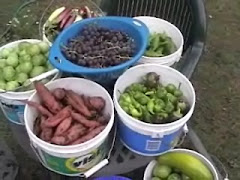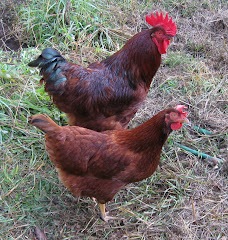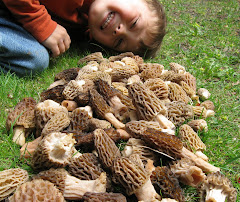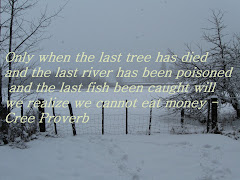The root cellar is our basement, we are lucky to live in an early 1900's cottage type house with a large cement basement that stays fairly cool year around. We keep potatoes,

carrots, beets,

kohlrabi, cabbage,

Belgian endive,

parsnips, turnips, apples, celery in the root cellar because the temperature and humidity is just about right for these crops. Squash,

onions,

and some of the tomatoes,


tomatillos, peppers,

eggplants are all kept in various parts of the house as it is less humid and has a more varied temperature range. Some of the tomatoes (Burpee Long Keeper) last all the way until spring if we are lucky. We also bring some pepper plants live in pots into the house in order to have peppers all the way into December.
We dry apples, pears, plums, tomatoes, walnuts, herbs, garlic, morel mushrooms, and beans.


Some are dried in the greenhouse and porch, but we do rely upon a food dryer for most of them as we have a very humid fall in our area that is not conducive to drying food.
The only herbs we freeze are basil and cilantro. We pick them, wash and dry the leaves as necessary, mix in a big bowl with a little olive oil and then pack them into freezer bags. This seems to make them keep better and allows us to easily separate the frozen leaves as needed. Tomatoes, tomatillos, ground cherries, and peppers are also frozen or made into sauce. Broccoli, beet greens, kale, garlic scapes and basil are made into a pesto and served over pasta. We also freeze some of the kale and use it in soups...it really freezes well and is an excellent addition to soups, omelets, or stir fry.
We freeze most of our berries

but are looking for alternatives to this as the berries make up about 60% of our freezer space. We had to use these two smaller freezers as a backup because our big one overfloweth, I suppose this is a good problem though , it's better to worry about not having enough space than not having enough stuff to fill my spaces.

If anyone has come up with a way to store berries in their natural state we would love to hear about it. We use them in smoothies for breakfast and would love to do away with freezing them but don't want the added sugar that canning would involve.
Below is a list I made several years ago to remind me not to forget any of my fall duties. The dates change according to the weather.
HARVEST SCHEDULE:
7/1 - 10/1- dry or freeze (basil & cilantro) herbs and make basil, broccoli pesto
9/01- pull beans for drying in greenhouse
9/15-25 - pull tomatoes (tomatoes in house for quick ripen and basement for slow ripen) and most peppers, tomatillos, ground cherries, and eggplants, pot up peppers to overwinter
9/15-25 - pick summer squash, check pear trees
9/25-10/1- pull and dry on porch, potatoes, winter squash, zucchini, cabbage, kohlrabi ( cabbage kohlrabi only if fearing frost, best to wait as long as possible) (remember that last November got really warm and I pulled cabbage, kohlrabi and potatoes to soon)
9/26-10/20- pick plums
10/1- get row covers ready
10/15-11/15- pot up for forcing, beets, dandelions, Belgian endive (do endive last), broccoli, cabbage plants, asparagus, parsley, and chard ...remember to bury extra greens in bags for the chickens
10/30-11/30- pot up rhubarb ( allow to frost for 3 weeks before bringing in ...see plant notes on forcing rhubarb)
10/1/-10/30- apples and cranberries
10/15- 11/01- pull carrots, pot up leeks, clean garden and greenhouse
11/01-11/15- cut back raspberry and grape vines






 grated carrots, beets, kohlrabi, turnips, and squash (yeah, raw grated squash) topped with onions, nuts, baked purple potatoes and sometimes fruit and berries are thrown in. We are able to eat this all year around fresh from our garden and root cellar. Many a breakfast is had with leftover salad and poached eggs thrown on top
grated carrots, beets, kohlrabi, turnips, and squash (yeah, raw grated squash) topped with onions, nuts, baked purple potatoes and sometimes fruit and berries are thrown in. We are able to eat this all year around fresh from our garden and root cellar. Many a breakfast is had with leftover salad and poached eggs thrown on top  or smoothies made from wild berries either gathered or grown. Once or twice a week we treat ourselves to a cooked meal which might be potato and kale soup,
or smoothies made from wild berries either gathered or grown. Once or twice a week we treat ourselves to a cooked meal which might be potato and kale soup, 



 An unrelenting North Idaho winter had us shoveling snow in May to allow for the planting of seeds. We sadly stood and watched under the barns tin roof as thunderous hail stones pelted our newly established crops into mush on the first of July forcing us to replant over half of the garden. August windstorms took out the runner beans, which were propped back up, more securely this time, and they went on to exceed our every expectation providing us with many gallons of fresh and dried beans.
An unrelenting North Idaho winter had us shoveling snow in May to allow for the planting of seeds. We sadly stood and watched under the barns tin roof as thunderous hail stones pelted our newly established crops into mush on the first of July forcing us to replant over half of the garden. August windstorms took out the runner beans, which were propped back up, more securely this time, and they went on to exceed our every expectation providing us with many gallons of fresh and dried beans. At the same time the corn was once again flattened so we constructed a rope grid to hold it up. Unfortunately between the hail and wind the corn didn't fare as well as the beans and it became fodder for our chickens. Lucky chickens. Aphids, leaf miners, and slugs haunted our salad greens and we were forced to cut many of them back in order to regain control over the bugs.
At the same time the corn was once again flattened so we constructed a rope grid to hold it up. Unfortunately between the hail and wind the corn didn't fare as well as the beans and it became fodder for our chickens. Lucky chickens. Aphids, leaf miners, and slugs haunted our salad greens and we were forced to cut many of them back in order to regain control over the bugs.
 Fortunately the chickens like them better with bugs...again, lucky chickens.
Fortunately the chickens like them better with bugs...again, lucky chickens. We share a sense of accomplishment and pride that we did not give in to defeat and persevered to endure whatever came our way. We took it on as a personal challenge to respect mother nature's unexpected and at times irritating ways but refused to give in - whatever she threw our way we came back with a fury of our own. Here are some personal notes for the first half of July.
We share a sense of accomplishment and pride that we did not give in to defeat and persevered to endure whatever came our way. We took it on as a personal challenge to respect mother nature's unexpected and at times irritating ways but refused to give in - whatever she threw our way we came back with a fury of our own. Here are some personal notes for the first half of July. 







